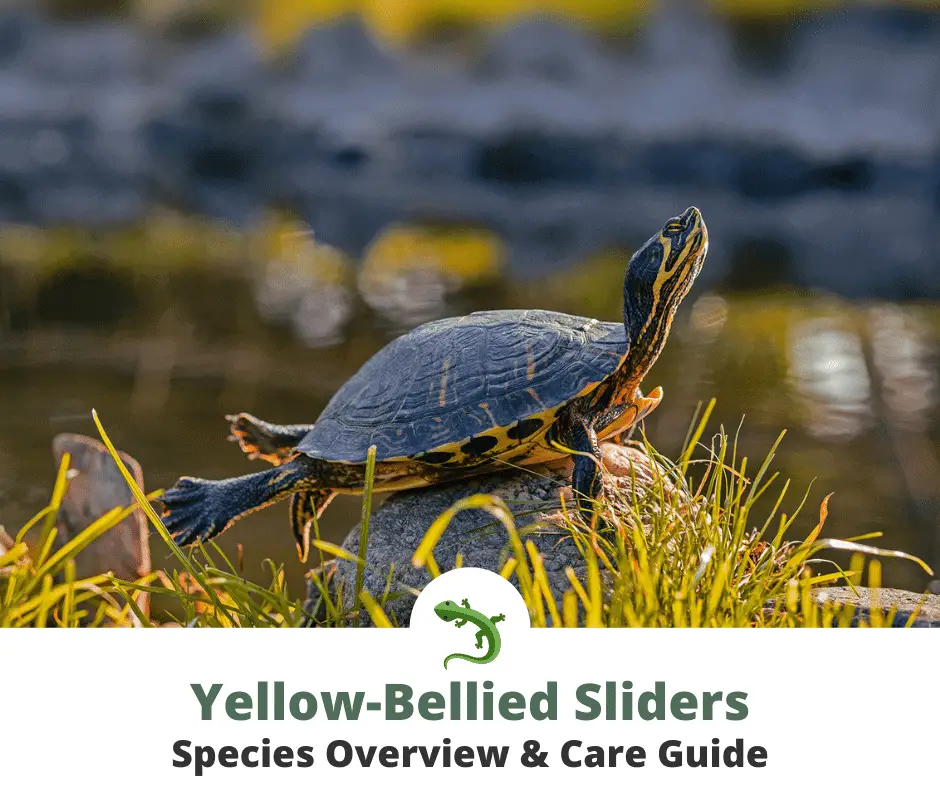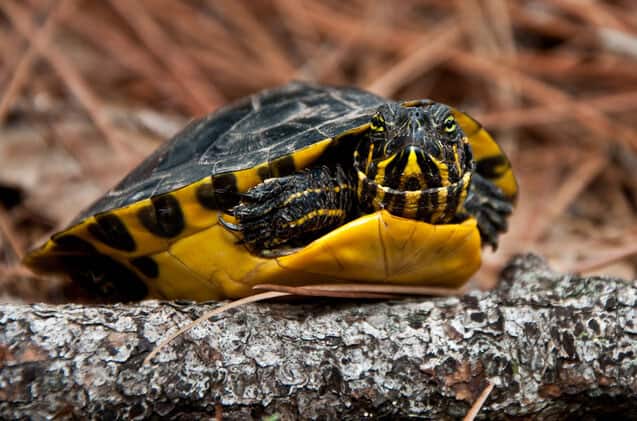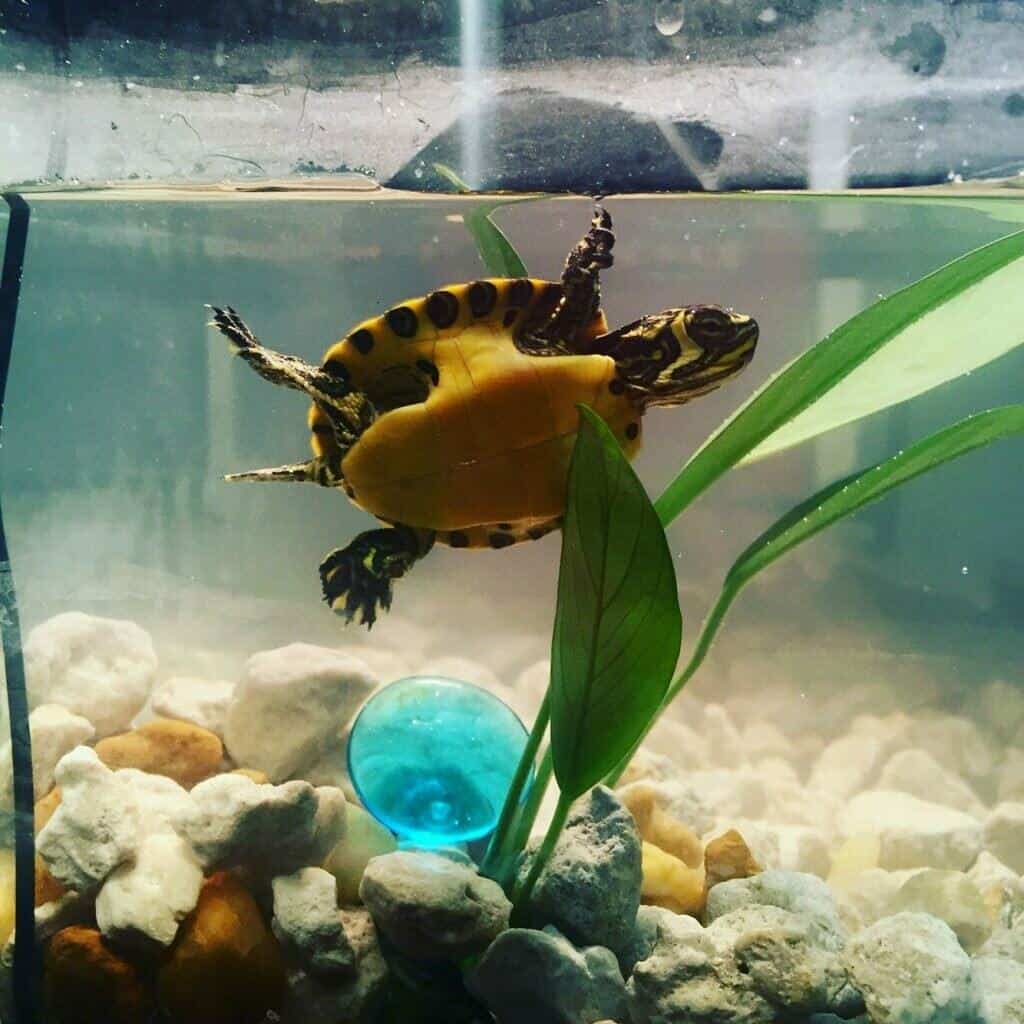Considering a Yellow-bellied slider for a pet? This guide will teach you the basics of the species as well as how to care for a yellow-bellied slider.
You’ll learn:
- How big do yellow-bellied sliders get?
- How long do they live?
- Are they good pets?
- What kind of care do they require?

Yellow-bellied sliders (YBS) are another popular option for turtles as pets and are known for their unique yellow markings on their underside and shells. They can live between 30-40 years in captivity and are moderately easy to care for. Usually, with turtles, it’s their tank that will need a lot of maintenance. These are related closely to red-eared sliders and will need big tanks as adults as they can grow from 8-12 inches long on average.
Species Overview
| Scientific name | Trachemys scripta scripta |
| Common name | Yellow-bellied slider, yellow-bellied terrapin, YBS |
| Adult size | Up to 9 inches for males and 13 inches for females |
| Distinguishing marks | Brown or greenish-black shells with yellow stripes on their shells with a yellow underbelly (plastron/lower shell) with black spots. |
| Distribution | North America, more commonly found in the Southeastern US (Florida and Virginia) |
| Habitat | These turtles are found in freshwater habitats such as lakes, ponds, streams, and rivers |
What Do They Look Like?
Yellow-bellied sliders are known for their olive green colored shells with distinct yellow stripes and a yellow underbelly (plastron) with black spots.

How Long Do They Live?
These turtles are long time pets since they can live from 30-40 years in captivity, if properly cared for.
How Big Do They Get?
Adult males average from 5-9 inches long while adult females average from 8-13 inches long.
📚 Read More >> Turtles That Stay Small
Behavior and Temperament
Most turtles will not like being handled and YBS are no different. However, they can get used to it especially if you get them as hatchlings or juveniles and allow them to get used to being held.
In the wild, these turtles will be active during the day, spending most of it basking in the sun. They usually eat in the morning while in the water.
Yellow-bellied sliders are curious and pleasant reptiles that make good pets especially when well cared for.
How To Care For A Yellow-Bellied Slider
Caring for a Yellow-bellied slider properly entails getting the correct tank size, keeping the water clean, providing proper heat and lighting, and giving it a proper diet and nutrition.
Housing the Yellow-Bellied Slider
Tank Size & Dimensions
These turtles will grow big so prepare to get a large tank for their habitat. As hatchlings, they can be housed in 15-20 gallon tanks but in general, fully grown adults should be kept in 75-100 gallon tanks. Bigger tanks are better since these give them more room and are usually easier to clean. If you want to keep more than one YBS in a tank, add an additional 20 gallon for the tank size per turtle. Turtles will not need deep water levels so getting a wider tank vs. a taller one is okay.
📚 Read More >> Best Turtle Tanks
After the tank, the next investment you should make would be a top-rated and good quality filtration system, since keeping your turtle tank’s water clean is the best way to keep them in the best of health. Turtles also tend to be messy so a powerful filter will make cleaning easier. Turtle tanks will also need a basking spot that will stay completely dry.
Plants (artificial or real) are also a good addition for your tank as well as a hiding place for your turtle.
Temperature & Lighting
Light
Turtles, like most reptiles will need a sufficient amount of UVA and UVB light to help them synthesize vitamin D3 for good calcium absorption. This helps prevent diseases such as metabolic bone disease and regulates their metabolism and digestion. They usually get UV light and heat naturally from sunlight but will need specialized lamps in captivity.
Full spectrum fluorescent bulbs that produce UVA and UVB rays need to be installed in your turtle’s tank, preferably above its basking spot with the heat lamp. A mercury vapor bulb will provide both UV rays, light, and heat for your turtle. Tank lighting should be on a 12 hour light/dark cycle and UV bulbs should be replaced every 6 months.
Heat
YBS are ectothermic creatures (cold-blooded) and will need heat in their tanks to regulate their body temperature. The correct temperature/heat ensures a good appetite and metabolism for turtles. Incandescent heat bulbs or basking bulbs that are 60-100 Watts depending on the temperature in your house is needed in your turtle’s basking area to maintain the correct temperature for basking.
📚 Read More >> Best Turtle Tank Water Heaters
For reference, the basking temperature in their tank should be about 80-90°F, the air temperature should be about 80-85°F, and the water temperature should be about 75-80°F.
What Do Yellow Bellied Sliders Eat?
Yellow-bellied sliders are omnivores so they eat both plants and meat in the form of fish and insects. As hatchlings and juveniles, they tend to be more carnivorous and then become more herbivorous as adults (especially female adults).
Turtles in captivity are usually fed turtle food/pellets, small feeder fish, or commercially bred insects such as mealworms, waxworms, and crickets (as treats). Then vegetables such as dark, leafy greens make for a well balanced diet.
Pond plants
With plants, always avoid those that are toxic to turtles such as hemlock, milkweed, and ivy.
Water lettuce or water weeds are plants that are easy to grow in your tank and will be safe for you YBS to eat. Turtles will consume this quite fast so prepare to replace them often.
Animal-based protein
Turtles can be fed dried shrimp, crickets, dubia roaches, locusts, salmon and feeder fish as a source of animal-based protein. Fatty food such as fish and worms will usually be reserved as treats.
Vitamin/ mineral supplements
Calcium supplements (usually offered as a powder you can use to dust turtle pellets or crickets before feeding) are a recommended supplement for turtles to prevent metabolic bone disease. These can also be offered as cuttlebones that your turtle can munch on.
Vitamin A can also be provided but make sure your turtle does not overdose on this. Getting vitamin A from food such as carrots, squash, and dark, leafy vegetables is also a good alternative. Vitamin D is usually not needed as long as you have proper UV lighting for your turtle.
Common Health Problems
Pneumonia is a common health problem for turtles especially if you see them floating often. Symptoms of respiratory infections in yellow-bellied sliders include closed and puffy eyes that look infected. They may also wheeze or drool.
Shell rot is a common health problem in all turtles which is signified by white or yellow colored spots on their shells that are either soft or crumbly.
Prevent infections and shell rot by keeping your turtle’s tank clean and at the proper temperature. Your turtle’s water should be well filtered, clean, and will need water conditioners to keep the water quality at optimum levels for its good health.
Metabolic bone disease is another common health problem for turtles which is caused by poor diet and inappropriate lighting. This can be painful and life threatening for turtles.
Make sure to consult your veterinarian if you notice something off about your turtle.
How To Choose A Yellow-Bellied Slider
When choosing your yellow-bellied slider from a pet store, always watch out for any signs of illnesses such as: puffy or closed eyes; discharges from the nose, eyes, or mouth; lethargy; and shells that have soft or rough discolored spots.
You should also check if the turtle is responsive by checking its reflexes. Do this by giving its legs a quick, gentle tug or pull. The turtle should also try to swim away when you reach for it or handle it. Most turtles do not like handling so this is normal behavior.
In pet stores, a good rule of thumb is to observe the enclosure’s cleanliness as well. If the tanks in the pet shop are well kept, then you can be sure the turtle you are getting is in good shape.

Opt for captive bred turtles as those caught from the wild will likely have parasites or other infections that can affect humans as well. As always, make sure you are getting your reptiles from reputable breeders.
Expect to spend about $10-20 on hatchlings and anywhere from $70-100 for adults.
Can Yellow-Bellied Sliders Be handled?
Yellow-bellied sliders, like most turtles will not take to handling too well. This will usually cause undue stress for them but over time, they can get accustomed to being handled, especially if you start getting them used to you at a young age. However, they can bite if they feel threatened (and they have pretty strong jaws) so be careful. That being said, YBS are often considered the more sociable member of the slider family of turtles.
FAQs
Are Yellow-bellied Sliders Endangered?
No, yellow-bellied sliders are classified IUCN 2.3 (International Union for Conservation of Nature) which stands for “least concern.” They have been bred in captivity with success and are popular pets. Sometimes, these turtles are considered invasive species in some ponds and natural freshwater habitats in the country. These turtle populations are usually from irresponsible pet owners who release their turtles in the wild.
Are yellow-bellied sliders good pets?
Yes, yellow-bellied sliders make good pets. Though turtles are not fond of being handled, they are curious critters. However, keep in mind that they can be messy, and keeping turtle tanks in top shape will require effort.
Can you put fish with Yellow-bellied Sliders?
Yes, you can put fish in with YBS either as their food source or as tank mates. If you want to keep the fish as pets as well (or use them as additional tank cleaners), choose fish that are small and fast and can easily escape predation by your turtles. You can also opt for larger fishes but steer clear from large predatory fish like bass, large African cichlids, and large catfish as these will attempt to eat your turtle. As a rule, turtles must be larger than the fishes’ heads.
Keep in mind that fishes will require higher quality water with the proper water chemistry levels to thrive. Turtles are a bit more tolerant, so with fishes, you will have to pay more attention to keeping the water in your tank cleaner. Yellow-bellied sliders will do well in the water conditions appropriate for most freshwater pet fishes.
Can yellow bellied sliders live in cold water?
Yes, yellow bellied sliders can live in cold water but there is a proper temperature range to keep them healthy (75-80°F). They will survive in colder water but it will prompt turtles to hibernate which slows down their metabolism and not allow them to absorb nutrients from food efficiently. Indoor turtles or turtles kept as pets will not need to undergo hibernation.
Do yellow bellied sliders have teeth?
No, yellow-bellied sliders do not have teeth but they can bite and they bite hard! Turtles have a kind of beak made of a keratin layer. These are rigid and are used along with their jaws to cut and chew food.
Do yellow bellied sliders get lonely?
No. Turtles can actually get territorial especially when kept together in small tanks. It’s usually best to keep one turtle to a tank or have at least a 120-150 gallon tank if you opt to keep several.
Conclusion
Yellow-bellied sliders make great pets with the proper care (especially in keeping their tanks clean) and can be life-long companions as they can live up to 40 years in captivity.
Further Reading
Quick facts and care sheets:
Care Sheet – Yellow-Bellied Slider
Yellow-bellied Slider (Trachemys scripta scripta) – Species Profile
More detailed information on the yellow-bellied slider:
Virginia Herpetological Society: Yellow Bellied Slider
Other diseases that infect turtles:



4 thoughts on “Yellow-Bellied Sliders: Care Guide, Species, Diet, & Habitat Setup”
Is it normal for the ybs to have some green lines in their shell
Yes! Completely normal and not uncommon.
In general, is it okay to mix different species of turtles ex: YBS,RES or painted turtles together in a small pond?
Hi there,
It totally depends on a multitude of factors. The primary factor to consider is the amount of space you have and the compatibility of the two species/requirements.
If the two animals share a similar habitat and care (such as a YBS and RES or painted turtle), you’re one step closer to being able to cohabitate the animals. Next, consider the size of the two turtles. If there is not a notable size difference amongst the turtles (over 2-4” size difference), you’re one step closer to housing them together! Please note, you CAN house turtles together disregarding this information, but there’s an increased risk of something going wrong or aggression amongst the species.
Finally, the amount of space you have can drastically increase the probability of successful cohabitation. Basically, the more room there is for the turtles to avoid one another and have plenty of spots to hide and visual barriers, they should be just fine together. It also depends on what size a “small” pond is. Anything less than 100 gallons I would not house two adult sliders or painted turtles together in.
At 150 gallons, you may comfortably house two, MAYBE three animals together (it also depends on personality, some turtles are more relaxed and tolerable than others!). The more room, the easier a time you will have keeping these species together. Hope this helped!